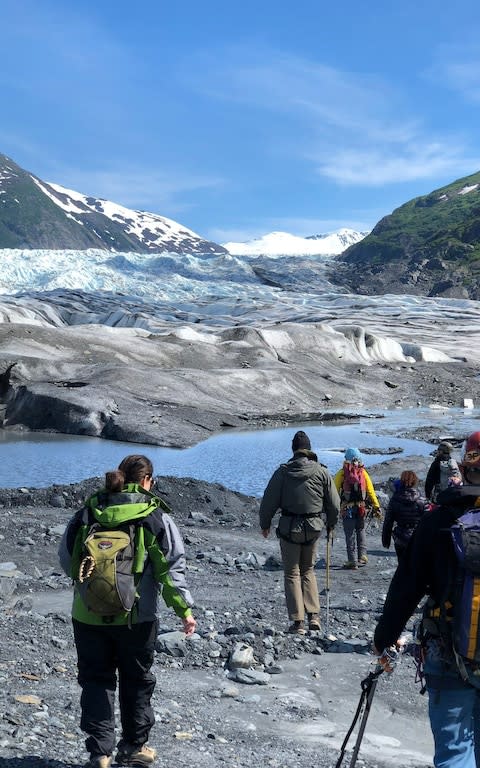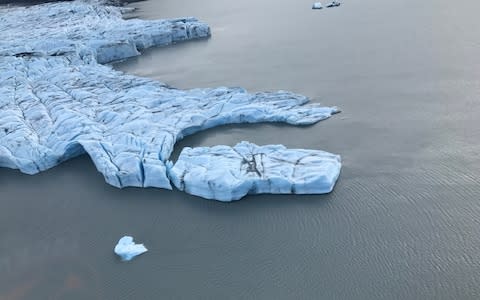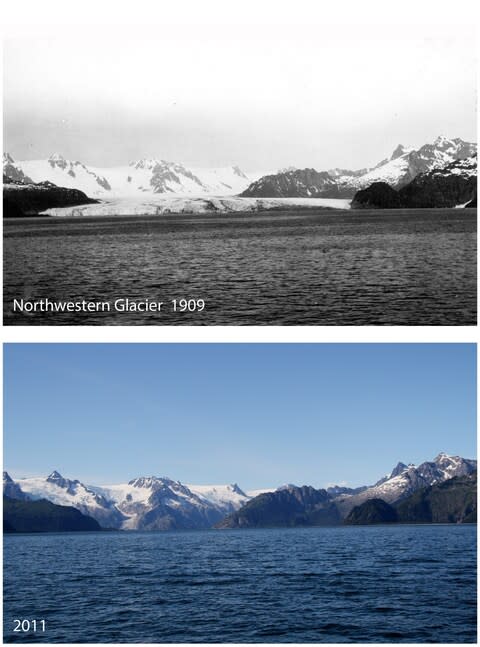Fears over Alaska's shrinking glaciers fuels tourism boom

Fears over melting glaciers are also fuelling a tourism boom in Alaska, with visitors flocking to the region to see the spectacular formations in their current glory.
Rising summer temperatures in recent years have contributed to the rapid decline of a number of storied glaciers, as well as making them harder for travellers to access.
Climate scientists have warned that Alaska's glaciers are uniquely vulnerable to the warmer summer seasons and are losing mass at an increasingly fast pace.
But as people become more aware of the perils of a changing climate, a desire to see Alaska's spectacular landscape sooner rather than later seems to have taken hold.
Tour companies in the region are reporting a huge increase in demand for glacier-related activities, while cruise ships experienced a record season last year, with the number of customers up 33 per cent compared to 2010.

Peter Schadaee, from Anchorage Helicopter Tours based in south central Alaska, said he has seen the changes to the area first-hand in the 15 years he's been doing glacier helicopter tours.
"The glaciers are getting thinner," he told the Telegraph. "Most used to be a big vertical wall that we fly to and that really diminished over time to nothing really."
"And obviously we see the glacier a quarter mile shorter than it was 10 years ago. Colony Glacier terminates into a lake so you do have a vertical wall but we've seen the glacier recede so much that there's this big piece of mountain coming out of the glacier that we've never been able to see before."
Mr Schadaee said they had seen the number of customers increase ten fold in the last few years. He said: "Now people are engaging definitely in issues about climate change and we try to answer that honestly and not politically but the change is obvious. And it's happening fast, every year we notice changes."

Heather Szundy, co-owner of Ascending Path Guides, said the company has had to "abandon several glaciers" since 2003 because they have become too thin to walk on. She said their tours on the Spencer glacier, which they've run since 2007, have had to adapt to the glacier's decline and are now limited to helicopter-only access for guided hikes.
"We can't offer our most popular trip anymore, because there's too much melting," she said.
"We found out at the end of March we weren't able to walk on the glacier and we had 200 people booked and the majority cancelled because they were set on getting on the glacier for a certain price, and when it wasn't available they weren't happy about it."
She added: "I definitely think that the means to actually get on to a glacier, touch a glacier, it's going to be getting harder to do that as time goes on... there's more land in the way to access the glacier, so what used to maybe be a two-mile hike to walk on a glacier is maybe three, and then you add on difficulty, so even for mountaineers glaciers are getting more arduous to access, and definitely for tourists because most of them are not mountaineers."

Overall, the number of visitors to the state was 27 per cent higher in 2018 than a decade ago, according to the Alaska Travel Industry Association.
The number is only set to rise: more than two million out-of-state visitors are expected to travel to Alaska during this year's peak season.
But the increase in numbers is creating new challenges - with melting ice is making it harder than ever to access the shrinking glaciers, and creating safety problems of their own. Several injuries to tourists from collapsing ice have been reported in recent years. Indeed on a single day in 2017, two people were killed at separate glaciers in south-central Alaska.
Shad O'Neil, a geologist with the USGS government agency based in Anchorage, said "the region is losing mass at an increasing rate".
"People say glaciers have always melted and they're absolutely right - what's unique about today is they're melting so much faster than they're being replenished".
"What I think is scary is that the [Alaskan] glaciers are contributing to sea level at almost a rate of Antarctica and Greenland combined," he said.
He added: "A lot of the infrastructure that exists is no longer able to access the glaciers. People are flocking to see the tide water glaciers in Alaska and really many of them are in retreat... they're not really producing the giant icebergs of the past so it's not as spectacular."

It is not just the environmental changes that have fueled the exponential increase in visitors to the region, lower fuel prices and a broader range of airlines offering flights to the region has undoubtedly played a role.
Colby Lawrence, from Major Marine Tours in Seward, said the glaciers have not changed significantly in his area, and pointed out that there were a number of factors contributing to the increase in tourism. "I think many Americans see Alaska as a safe travel destination," he said, adding "it is a lot less expensive [to reach Alaska] than it was five years ago".
However he said the changes to the landscape was "certainly something that's talked about and people are interested in". "Certainly people know if they come in 15 to 20 years they could be gone," he said.

 Yahoo News
Yahoo News 
